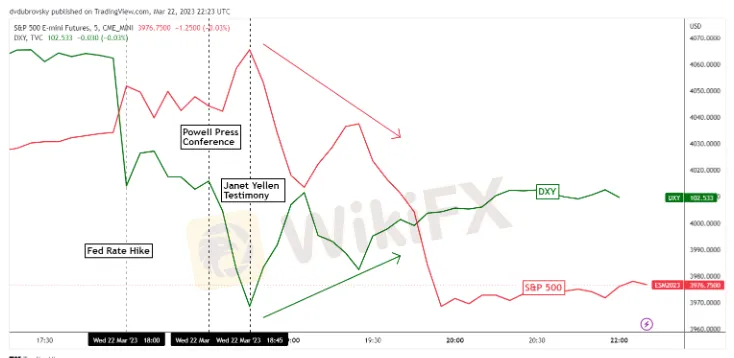简体中文
繁體中文
English
Pусский
日本語
ภาษาไทย
Tiếng Việt
Bahasa Indonesia
Español
हिन्दी
Filippiiniläinen
Français
Deutsch
Português
Türkçe
한국어
العربية
S&P 500 Sinks After Powell Speech and Yellen Testimony, Will US Dollar Rebound?
Abstract:The S&P 500 sank 1.6% on Wednesday in the aftermath of March’s Federal Reserve interest rate decision and accompanying press conference from Chair Jerome Powell.
S&P 500, US DOLLAR, JEROME POWELL, JANET YELLEN – ASIA PACIFIC MARKET OPEN:
The S&P 500 sank 1.6% in the aftermath of the Fed rate decision
Chair Jerome Powell tried pouring cold water on rate cut bets
Meanwhile, Janet Yellen testimony compounded risk aversion
Asia-Pacific markets appear to be bracing for volatility next
Asia-Pacific Market Briefing – Markets Reverse Gains on Fed Rate Decision
The S&P 500 sank 1.6% on Wednesday in the aftermath of Marchs Federal Reserve interest rate decision and accompanying press conference from Chair Jerome Powell. The central bank raised borrowing costs by 25 basis points, bringing the target range to 4.75% - 5%. Initially, markets welcomed the event as the statement noted that policymakers “anticipate” some extra firming might be appropriate.
That was cautiously downgraded from “ongoing increases” in the February statement, which was before Silicon Valley Bank collapsed earlier this month, triggering financial woes in the bank sector. But, markets turned after Jerome Powell noted that officials “just don‘t” see the case for rate cut this year. Since SVB’s bankruptcy, markets have been aggressively pricing in rate cuts this year.
A closer look reveals that median FOMC interest rate projections are still far more hawkish than what markets expect this year. Powell also stressed that if need be, they will raise rates higher than expected. The central bank also stressed that US banks are sound and resilient. Meanwhile, during Powells press conference, Treasury Secretary Janet Yellen was delivering testimony.
She noted that the government is not looking at offering “blanket” deposit insurance to stabilize the banking sector. This amplified selling pressure in regional banks, with First Republic Bank down over 15% by the end of the day. In the chart below, you can get a better idea of how price action evolved throughout these events and how the S&P 500 reversed and the US Dollar bottomed.
With that in mind, this is leaving Asia-Pacific markets vulnerable heading into Thursday‘s trading session. A lack of economic event risk is placing the focus on general market sentiment. As such, follow-through could dampen the mood for Japan’s Nikkei 225 and Hong Kongs Hang Seng Index. This may also offer some light for the US Dollar.

On the daily chart, the S&P 500 left behind a Bearish Engulfing candlestick. This followed what appears to have been a false breakout under a near-term falling channel from February. Further downside progress could open the door to resuming the downtrend. Immediate support is the 38.2% Fibonacci retracement level at 3938. Resistance is the 23.6% point at 4041.


Disclaimer:
The views in this article only represent the author's personal views, and do not constitute investment advice on this platform. This platform does not guarantee the accuracy, completeness and timeliness of the information in the article, and will not be liable for any loss caused by the use of or reliance on the information in the article.
Read more

Bank Negara Malaysia Flags 12 New Companies for Unauthorised Activity
Bank Negara Malaysia (BNM) has updated its Financial Consumer Alert List (FCA List) by adding 12 more entities, reinforcing its efforts to warn the public against unregulated financial schemes. Check if your broker made the list!

TradingView Brings Live Market Charts to Telegram Users with New Mini App
TradingView has launched a mini app on Telegram, making it easier for users to track market trends, check price movements, and share charts.

Georgia Man Charged in Danbury Kidnapping and Crypto Extortion Plot
Georgia man James Schwab charged in Danbury kidnapping tied to $230M crypto heist. Plot targeted couple for ransom after Miami altercation with son.

Bybit Shuts Down NFT Marketplace Amid Crypto Market Downturn
Bybit announces the closure of its NFT marketplace, citing efforts to streamline offerings. Discover the latest trends in the declining NFT market and its shift to utility-based growth.
WikiFX Broker
Latest News
The Withdrawal Trap: How Scam Brokers Lure Victims into Paying More
FCA to Investors: Think Twice Before Trusting These Brokers
Trump\s tariffs: How could they affect the UK and your money
Trump gambles it all on global tariffs he\s wanted for decades
TradingView Brings Live Market Charts to Telegram Users with New Mini App
Trump tariffs: How will India navigate a world on the brink of a trade war?
IG Group Acquires Freetrade for £160M to Expand UK Investment Market
U.S. March ISM Manufacturing PMI Released
Should You Beware of Forex Trading Gurus?
Exposed by SC: The Latest Investment Scams Targeting Malaysian Investors
Currency Calculator







